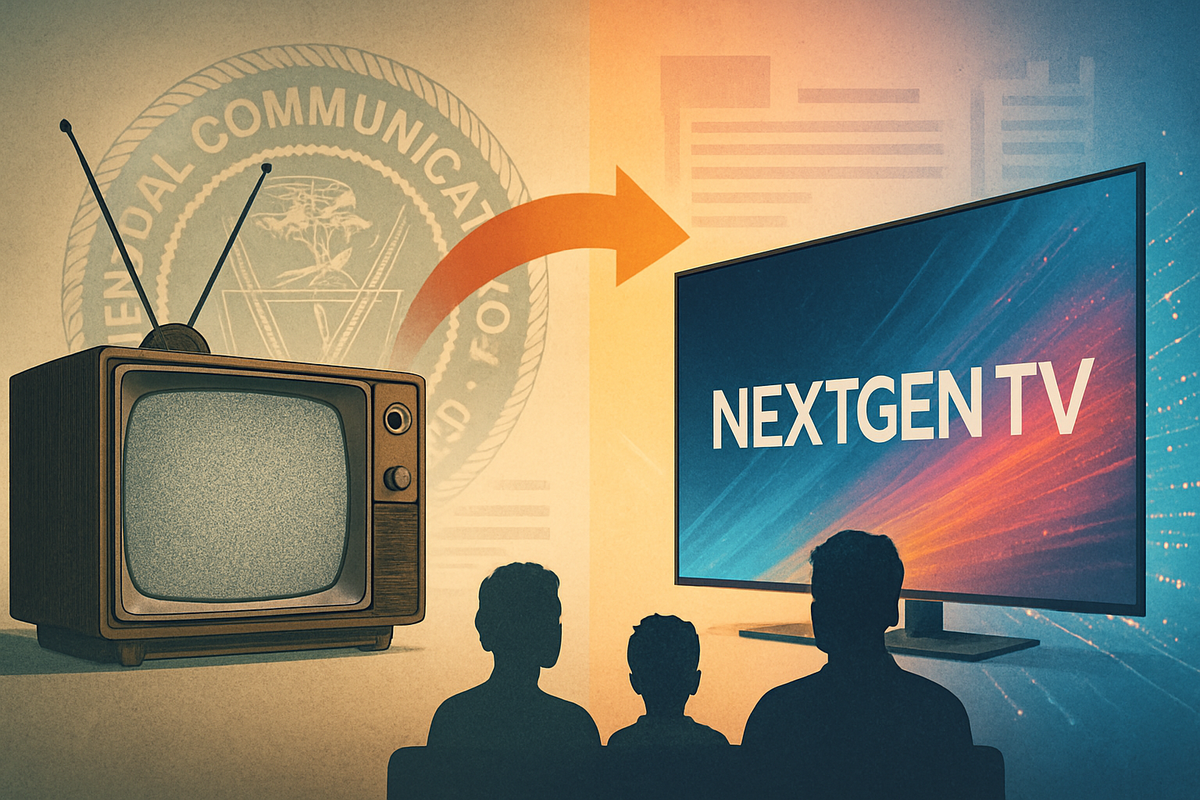
Washington D.C. – The Federal Communications Commission (FCC) is navigating a complex and pivotal phase in the evolution of American broadcasting, proposing a largely voluntary, market-driven transition to NextGen TV (ATSC 3.0) while conspicuously delaying any firm sunset date for the legacy ATSC 1.0 standard. As of early October 2025, the Commission has signaled a preference for flexibility over mandates, a stance that has ignited a fierce debate within the industry and carries profound implications for broadcasters, consumers, and technology manufacturers alike.
In a significant move ahead of its anticipated October 28 meeting, the FCC has circulated a "Fifth Further Notice of Proposed Rulemaking" (FNPRM) outlining a framework that would allow individual television stations to voluntarily determine when to transition from ATSC 1.0 to NextGen TV. Critically, this proposal also aims to eliminate the long-standing "substantially similar" simulcasting requirement, which currently mandates that core programming on both formats be identical. This relaxation is intended to free up bandwidth, allowing broadcasters to fully leverage ATSC 3.0's advanced capabilities, such as ultra-high-definition video, immersive audio, and interactive features.
The Shifting Sands of Broadcast Policy
The FCC's proposed rules represent a significant evolution in the regulatory approach to the NextGen TV transition. Central to the new framework is the proposed elimination of the "substantially similar" rule, which currently mandates that programming simultaneously broadcast on both ATSC 1.0 and ATSC 3.0 signals must be virtually identical. While simulcasting will remain an option, its compulsory nature is set to be removed, offering broadcasters unprecedented flexibility to leverage ATSC 3.0's advanced capabilities—such as 4K UHD video, High Dynamic Range (HDR), immersive audio, and interactive features—without the burden of content duplication on the older standard. This "substantially similar" rule had previously been extended until at least July 17, 2027, making its proposed earlier removal a notable development.
The journey to this pivotal moment has been characterized by intense industry debate and a measured rollout of NextGen TV. ATSC 3.0 services have already been deployed in over 90 markets, reaching an estimated 70-76% of the U.S. population, with over 14 million compatible devices now in consumers' hands. However, the transition has not been without its challenges, particularly the capacity constraints and operational complexities imposed by dual-format transmissions. The FCC's FNPRM seeks public comment on several other critical issues, including the regulation of digital rights management (DRM) and encryption, the potential requirement for all new U.S. televisions to include ATSC 3.0 tuners, and whether traditional pay-TV providers (Multichannel Video Programming Distributors or MVPDs) should be obligated to carry ATSC 3.0 signals under "must-carry" rules. The commission is also exploring mechanisms to offset consumer costs associated with the transition, acknowledging the financial burden of upgrading equipment. The upcoming October 28 vote will be a defining moment, potentially charting a new, more flexible course for the future of broadcast television.
Winners and Losers in the Evolving Broadcast Landscape
The FCC's proposed voluntary transition to NextGen TV (ATSC 3.0) and the delayed sunset of ATSC 1.0, while offering flexibility, creates a distinct set of winners and losers across the broadcasting, manufacturing, and content sectors. Companies that have proactively invested in NextGen TV technology are poised for significant gains, while others face prolonged operational complexities or market share challenges.
Among broadcasters, major groups that have championed and invested heavily in ATSC 3.0 are set to benefit immensely from the increased operational flexibility. Sinclair Broadcast Group (NASDAQ: SBGI) and Nexstar Media Group (NASDAQ: NXST) stand out as leading proponents and early adopters. Sinclair, through its subsidiary ONE Media 3.0, is deeply engaged in developing new business models, including wireless IP data delivery for applications like automotive connectivity, content delivery networks, and enhanced GPS. Similarly, Nexstar is leveraging ATSC 3.0 for advanced broadcasting services and targeted advertising. Both companies, along with Gray Media and The E.W. Scripps Co., formed "EdgeBeam Wireless" in early 2025, a joint venture specifically designed to capitalize on new data delivery services via ATSC 3.0, projecting billions in potential annual revenue. Other major broadcasters like Tegna Inc. (NYSE: TGNA), as part of Pearl TV and other coalitions, also stand to gain from enhanced broadcast capabilities and new revenue streams, strengthening their competitive edge against digital platforms.
Conversely, smaller broadcasters, particularly in rural areas, may face prolonged financial hurdles. While the voluntary approach offers flexibility, it also means maintaining dual ATSC 1.0 and ATSC 3.0 systems for an extended period, leading to increased operational costs without immediate, guaranteed returns. This could exacerbate the digital divide, making it harder for these stations to upgrade their infrastructure. Multichannel Video Programming Distributors (MVPDs) such as Comcast (NASDAQ: CMCSA), DirecTV, and DISH Network (NASDAQ: DISH) see a temporary reprieve, as the delayed ATSC 1.0 sunset gives them more time to phase in NextGen TV support at their own pace, mitigating the financial impact of a rapid, mandated transition.
In the television manufacturing sector, companies that continue to integrate ATSC 3.0 tuners into their products are well-positioned. Samsung Electronics (KRX: 005930) has been a leader, incorporating ATSC 3.0 tuners into its high-end TV lineups since 2020 and is expected to continue this trend, capitalizing on consumer demand for advanced features. Other players like Sony (NYSE: SONY), Hisense, and TCL are also actively offering NextGen TV-compatible sets, poised to gain market share as the installed base of NextGen TV products grows. The prolonged transition also bodes well for manufacturers of accessory receivers (e.g., ADTH, Stavix, Zapperbox), as consumers may opt for external tuners to access NextGen TV features without purchasing an entirely new television. A notable exception is LG Electronics (KRX: 066570), a co-developer of ATSC 3.0, which announced in September 2023 its decision to cease including ATSC 3.0 tuners in its 2024 U.S. TV lineup due to patent infringement lawsuits and increased licensing fees. This move positions LG as a significant loser in the immediate U.S. NextGen TV tuner market, potentially ceding ground to competitors.
Content providers, while facing the challenge of prolonged dual-standard support, stand to benefit significantly in the long term. ATSC 3.0's capabilities—4K UHD video, HDR, immersive audio, and targeted advertising—offer new avenues for delivering higher-fidelity content and enhanced monetization. The IP-based nature of NextGen TV facilitates hyper-localization and interactive applications, boosting viewer engagement and offering new revenue streams comparable to digital platforms. However, the voluntary transition means they must continue to cater to the ATSC 1.0 audience, requiring sustained investment in dual infrastructure and strategies until the full benefits of NextGen TV can be realized across the market.
Wider Implications: Redefining Broadcast in the Digital Age
The FCC's proposed voluntary transition to NextGen TV and the delayed sunset of ATSC 1.0, while seemingly a regulatory nuance, carries profound wider significance for the media industry, underscoring fundamental shifts in how content is delivered and consumed. This decision reflects a cautious approach aimed at balancing technological advancement with consumer protection and industry stability, yet it also ushers in a period of strategic recalibration for all stakeholders.
This event fits squarely into the broader industry trend of convergence between traditional broadcasting and internet-based streaming. NextGen TV, with its IP-based foundation, is designed to bridge this gap, offering capabilities like 4K UHD, immersive audio, and interactive features that directly challenge the offerings of streaming platforms. Broadcasters can now deliver on-demand functionality, improved content discovery, and personalized advertising, mimicking the agility of digital competitors. Crucially, ATSC 3.0 unlocks significant potential for data services, allowing broadcasters to leverage their spectrum for non-media applications such as transmitting technical updates to connected devices, providing terrestrial backup to GPS, and even becoming integral to smart city infrastructure. This represents a substantial new revenue stream, potentially generating billions annually and redefining the broadcaster's role beyond traditional content delivery. The integration of AI is also a burgeoning trend, with NextGen TV seen as a foundation for "AI-driven media," enabling sophisticated intelligence for content recommendations, production, and metadata management.
The ripple effects of this voluntary transition are widespread. For broadcasters, particularly large groups like Sinclair Broadcast Group (NASDAQ: SBGI) and Nexstar Media Group (NASDAQ: NXST), the flexibility to innovate and pursue new data-centric business models is a boon. However, smaller and non-commercial stations face the daunting financial burden of upgrading infrastructure without a clear, mandated endpoint for ATSC 1.0, potentially exacerbating disparities. Multichannel Video Programming Distributors (MVPDs) like Comcast (NASDAQ: CMCSA) gain a reprieve from immediate, costly upgrades but face ongoing regulatory scrutiny regarding potential "must-carry" obligations for ATSC 3.0 signals. Consumer technology manufacturers, as exemplified by LG Electronics' (KRX: 066570) decision to halt ATSC 3.0 tuner inclusion due to patent disputes, face a "coordination problem." Without a mandatory sunset, market demand alone might not drive rapid ATSC 3.0 tuner adoption, potentially slowing the overall transition. Furthermore, the datacasting capabilities of NextGen TV could create new partnerships or competitive dynamics with industries like wireless and automotive, as broadcasters carve out a niche in the data transport ecosystem.
Regulatory and policy implications extend beyond the immediate rules. The FCC's move towards a market-driven approach signals a broader shift towards deregulation, contrasting with previous calls for a mandatory transition. This raises questions about broadcast ownership rules, with some commissioners linking NextGen TV benefits to proposed changes that could disproportionately benefit large station groups. Consumer protection and the equitable distribution of transition costs remain central, with the FCC seeking comment on potential subsidies or incentives to mitigate the financial burden on consumers. The debate also continues on how broadcasters, with their newfound flexibility, will uphold public interest obligations related to localism, viewpoint diversity, and competition, particularly concerning the use of encryption or Digital Rights Management (DRM) on broadcast signals.
Historically, this transition draws comparisons to the analog-to-digital television (DTV) transition (ATSC 1.0) of the early 2000s. However, key differences are stark. The DTV transition was a congressionally authorized, mandatory shift with a hard sunset date and a multi-million dollar converter box program. In contrast, NextGen TV is a voluntary, market-driven evolution. While both transitions aimed for improved picture/sound and spectrum efficiency, ATSC 3.0 goes further by fundamentally redefining broadcasting as a "smart media hub" through IP-based delivery, interactivity, and mobile reception. This voluntary, slower pace, while designed to prevent consumer disruption, also introduces uncertainty and a potentially more fragmented adoption, a stark contrast to the unified, if challenging, DTV switch.
What Comes Next: A Gradual Evolution with Strategic Imperatives
The FCC's proposed voluntary transition for NextGen TV and the delayed sunset of ATSC 1.0 sets the stage for a gradual, market-driven evolution of broadcast television. In the short term (next 1-3 years), the landscape will see a continued, steady rollout of NextGen TV services, now available to 75-80% of U.S. households. Broadcasters, unburdened by strict "substantially similar" simulcasting rules, can more aggressively pursue immediate monetization opportunities through targeted advertising, datacasting, and enhanced interactive features. The focus will be on differentiating ATSC 3.0 offerings with 4K HDR video, immersive audio, and advanced emergency alerts. A critical challenge will remain bridging the consumer awareness gap, as many viewers are still largely unaware of NextGen TV's benefits.
Looking further ahead (beyond 3 years), the long-term possibilities present a more fragmented, yet potentially transformative, future. Without a hard deadline, ATSC 1.0 could persist for an extended period, leading to a patchwork of availability and potential consumer confusion. However, as more stations eventually transition exclusively to ATSC 3.0, they will reclaim full spectrum capacity, enabling a broader range of advanced services. A significant opportunity lies in the emergence of the Broadcast Positioning System (BPS), leveraging ATSC 3.0's precise timing signals as a critical complement to GPS, potentially gaining government backing for national security and infrastructure resilience. This could become a major driver for ATSC 3.0 deployment. The IP-based nature of NextGen TV also fosters the rise of hybrid broadcast-OTT models, seamlessly integrating over-the-air and internet content for richer, more interactive experiences. While the FCC currently favors a voluntary approach, persistent slow adoption could lead to a reconsideration of mandates for ATSC 3.0 tuners in new TVs or MVPD carriage obligations.
Strategic pivots and adaptations are paramount for all industry players. Broadcasters must aggressively embrace innovation for monetization, developing new business models around datacasting for diverse industries like automotive, logistics, and digital signage. They need to modernize content workflows for 4K HDR and immersive audio, and critically, invest in robust consumer education campaigns to drive demand for compatible receivers. Partnerships, such as "lighthouse" arrangements for spectrum sharing, will also be vital. Manufacturers, including Sony (NYSE: SONY), Samsung Electronics (KRX: 005930), Hisense, and TCL, will continue voluntary integration of ATSC 3.0 tuners into premium sets, while also focusing on developing affordable external converter boxes to lower the barrier to entry for consumers. Content providers must modernize production workflows to support higher technical specifications and develop interactive, personalized content that leverages ATSC 3.0's IP capabilities. Addressing Digital Rights Management (DRM) and security concerns will also be crucial to protect premium content while ensuring consumer access.
Emerging market opportunities abound, particularly in datacasting, which represents a significant greenfield for broadcasters to diversify revenue beyond traditional advertising. Enhanced advertising models through highly granular targeted advertising will allow broadcasters to compete more effectively with digital platforms. Public safety, through advanced emergency alerting and BPS, offers crucial public service benefits that could attract government support. However, significant challenges persist, notably low consumer awareness, the substantial cost of transition for many broadcasters, and the "coordination problem" posed by a fragmented market. Uncertainty around MVPD carriage obligations and potential DRM controversies also pose hurdles. Ultimately, the industry faces potential scenarios ranging from a prolonged, market-driven evolution where ATSC 1.0 coexists with 3.0 for many years, to an optimistic outcome driven by "killer apps" and policy nudges that accelerate adoption, or a pessimistic scenario where NextGen TV remains a niche product, struggling to realize its full potential. The coming years will be defined by how effectively the industry collectively demonstrates the value proposition of NextGen TV to the American public.
The Long View: A Defining Moment for Free-to-Air Television
The FCC's cautious, market-driven approach to the NextGen TV transition, coupled with the delayed sunset of ATSC 1.0, marks a defining moment for free, over-the-air television in the United States. While designed to minimize immediate disruption for consumers, this strategy introduces a prolonged period of uncertainty and dual-standard operations that could either foster organic innovation or hinder the full potential of NextGen TV.
Key Takeaways: As of October 2025, the FCC is proposing a voluntary transition, actively resisting calls for a mandated ATSC 1.0 sunset and favoring greater flexibility for broadcasters by eliminating the "substantially similar" simulcasting rule. This stance, however, highlights a significant divide within the industry, with major broadcasters pushing for mandates to accelerate adoption, while consumer technology groups express concerns about increased costs for consumers. The shadow of ongoing patent litigation (e.g., between Constellation Designs and LG Electronics (KRX: 066570)) also looms large, potentially impacting the availability and pricing of NextGen TV-capable devices.
Market Assessment Moving Forward: The market faces a complex trajectory. Broadcasters, particularly those who have invested heavily like Sinclair Broadcast Group (NASDAQ: SBGI) and Nexstar Media Group (NASDAQ: NXST), are poised to capitalize on new revenue streams from datacasting and targeted advertising, but their full monetization is hampered by the prolonged ATSC 1.0 presence and slower consumer device penetration. Consumers, while spared an immediate need to upgrade, face a fragmented viewing experience and a persistent awareness gap regarding NextGen TV's benefits. Manufacturers navigate conflicting signals, with some voluntarily integrating ATSC 3.0 tuners into premium sets, while others, like LG, have exited the market due to patent disputes.
Significance and Lasting Impact: This juncture is a "break glass moment" for free, over-the-air television. NextGen TV promises a transformative upgrade, delivering a broadcast experience comparable to, or even exceeding, current streaming services in quality and interactivity. Its potential for advanced emergency alerts, offering precise geographic targeting even without internet connectivity, is a significant public safety benefit. However, the FCC's voluntary path risks an uneven transition that could delay the full realization of these benefits. The fundamental question of whether free over-the-air television will remain "free" if broadcasters increasingly rely on encryption for new services looms large and could redefine the relationship between viewers and local stations.
Investor Advisory: What to Watch in the Coming Months: For investors in the broadcast and media sectors, the next few months will be critical. Watch closely for the FCC's final decision on the NPRM later in October 2025, as its stance on mandates and the voluntary framework will profoundly shape market trajectory. The outcome of the Constellation Designs-LG patent case is also a critical factor, as it could reshape the competitive landscape for device makers. Monitor consumer adoption metrics for NextGen TV-capable devices; slow uptake could prompt renewed calls for regulatory intervention. Finally, keep a close eye on the progress of datacasting ventures like EdgeBeam Wireless. Early successes in monetizing these new services will be a strong indicator of NextGen TV's commercial viability beyond traditional advertising, highlighting leaders and laggards in this pivotal transition.
This content is intended for informational purposes only and is not financial advice




